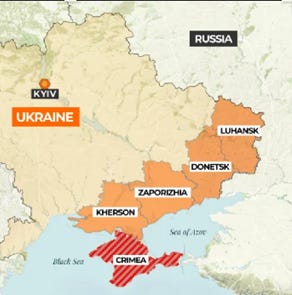When Presidents Trump and Putin met in Alaska the other day, there was little hope of an immediate ceasefire. The Russians have long made it clear that they no longer trust the West. Indeed, they have good reason to “Trust but verify!”
America’s leaders were warned about Russia’s position on Ukraine before Putin was born. Instead, they have allowed their arrogance to create this situation. After the collapse of the Soviet Union, Russian leaders, starting with Gorbachev, tried to link Russia economically with Europe and avoid military conflict. Their effort was rejected at every turn.
After World War II, George Kennan was the acknowledged expert on the Soviet Union and Russian leaders. The must-read paper on the Soviets was his famous “The Sources of Soviet Conduct” in Foreign Affairs, July 1947. It is known as the “X” paper because it was published under that pseudonym.
In the January 27, 2023, issue of Foreign Affairs, Frank Costigliola wrote about Kennan’s remarkably accurate set of warnings about Russia’s attitudes and actions regarding Ukraine. He began by recounting Kennan’s most notable moments.
Kennan helped craft the Marshall Plan and other major midcentury initiatives.
Kennan’s star would dim after 1949 as he opposed the growing militarization of U.S. foreign policy, but he was still venerated as a Russian expert. His advice was sought by the Truman administration … by the Eisenhower administration after the death of Stalin … , and by the Kennedy administration during the Berlin crisis of 1961. …Kennan was consulted by officials in the State Department and in the CIA well into the 1990s.
Costigliola then describes an internal State Department Planning Paper published in 1948 with Kennan’s views. I note the year 1948 because Putin was born in 1952. Some people think this problem can be solved by replacing Putin. That is false. Kennan’s 1948 description of Russia’s attitudes shows that Putin is entirely in line with conventional Russian thought. Costigliola writes:
[T]wo problems identified by Kennan three-quarters of a century ago have persisted, particularly in the minds of Russian leaders… He wrote in a State Department memo that “there is no clear dividing line between Russia and Ukraine, and it would be impossible to establish one.” Second, the Russian and Ukrainian economies were intertwined. Setting up an independent Ukraine “would be as artificial and as destructive as an attempt to separate the Corn Belt, including the Great Lakes industrial area, from the economy of the United States.”
… For all these reasons, a hypothetical triumphant United States should not seek to impose Ukrainian independence on a prostrate Russia.
When the Soviet Union collapsed, the surviving Russian leadership wanted to see Russia as part of a commercial partnership with Europe. Since the Soviet Warsaw Pact was gone, they saw no need for the continued existence of the West’s anti-Soviet military alliance known as NATO. As part of the discussions about the reunification of the two Germanies, the U.S. Secretary of State James Baker assured Russian leader Mikhail Gorbachev that “not an inch of NATO’s present military jurisdiction will spread in an eastern direction.”
In 2000, Putin was about to become the Russian President, and he gave an interview to David Frost:
He clarified his intention: “Russia is a part of European culture, and I do not consider my own country in isolation from Europe. Russia is part of the European culture. And I cannot imagine my own country in isolation from Europe and what we often call the civilized world. So it is hard for me to visualize NATO as an enemy.”
But even though the Cold War was over, a very belligerent anti-Russian strategy became policy in the 1990s. Sameed Basha described this change in a February 18, 2023, article in The National Interest.
The Wolfowitz Doctrine, named after then U.S. under-secretary of defense Paul Wolfowitz, was leaked to The New York Times in 1992. The crux of the policy underscored American supremacy at all costs in a post-Soviet world and “stamping out rivals wherever they may emerge.”
Basha then tracks Putin’s growing frustration as NATO continued to add nations on Russia’s borders to its ranks. Putin saw elections overturned by courts when the public tried to elect neutral governments. There were “Astroturf Color Revolutions” funded by money from USAID and the U.S. National Endowment for Democracy, as well as money from George Soros.
In 2014, Ukraine had a moderate government working to maintain a balance. The votes of the Russophone Oblasts (provinces) in southeastern Ukraine had kept the elections balanced. Prime Minister Viktor Yanukovych tried to be even-handed. He had offered Russia a 99-year lease for the naval port at Sevastopol and did not officially join NATO, but he was not limiting the freedoms of the western Ukrainians. A ”spontaneous” Maidan uprising occurred, leading to an “Orange Revolution” and new elections. In addition to visits by U.S. Senators, there is overwhelming evidence of American leadership and cash in the effort.
What followed was a campaign to stamp out the Russian culture in Ukraine. The four eastern provinces, which are heavily Russian, resisted. International accords were created in Minsk in 2014 and 2015 to stop the fighting. Sadly, Angela Merkel later admitted that the agreements were created only to give Kyiv time to get stronger.
Crimea had been part of Russia until 1954. With the 2014 Ukrainian chaos, Putin reclaimed it militarily, held a referendum, and declared it a Russian oblast.
Basha concludes:
From Putin’s perspective, invading Ukraine in 2022 was the only option to signal to the Transatlantic alliance that Russia is now in an economic and geostrategic position to counter any further expansion–that Moscow remembers how the broken promises Baker made to Gorbachev, that the line has been drawn in the sand, and the Wolfowitz Doctrine shall advance no further.

